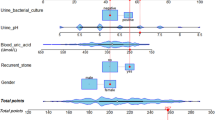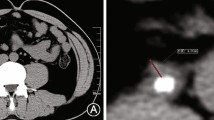Abstract
Purpose
The ability to objectively predict which emergency department patients are likely to have a ureteral stone may aid in cost-effectiveness and patient-centered diagnostic imaging decisions. We performed an external validation of the STONE score, a clinical prediction rule for the presence of uncomplicated ureteral stones in emergency department patients developed at Yale University School of Medicine.
Methods
Five hundred thirty-six (536) consecutive patients evaluated in an urban tertiary care emergency department for the possible diagnosis of ureteral stone were retrospectively reviewed. The STONE score uses five factors (gender, duration of pain, race, nausea/vomiting, erythrocytes on urine dipstick) to categorize patients into low, medium, and high probability of having a ureteral stone. The total STONE score risk is 0–13 and divided into three groups: low risk = 0–5, moderate risk = 6–9, and high risk = 10–13.
Results
Of the 536 patients evaluated for suspected ureteral stone, 257 (47.8 %) had a ureteral stone. Mean patient age was 45.9 years (SD 16.3), and gender distribution was 43.9 % female and 56.1 % male. Distribution of STONE score risk was 24.1 % low, 48.1 % moderate, and 27.7 % high. Diagnosis of ureteral stone by STONE score risk was 14 % for low-risk group, 48.3 % for moderate-risk group, and 75.8 % for high-risk group. This distribution is consistent with internal validation at Yale University School of Medicine, where values were 8.3–9.2 % for low risk, 51.3–51.6 % for moderate risk, and 88.6–89.6 % for high risk.
Conclusions
Our study validates the use of the STONE clinical score to categorize patients as low, moderate, and high risk for ureteral stone. This could help guide development of clinical decision rules for diagnostic studies and imaging in the future.
Similar content being viewed by others
References
Scales CD Jr, Smith AC, Hanley JM, Saigal CS (2012) Urologic diseases in America project. Prevalence of kidney stones in the United States. Eur Urol 62(1):160–165
Pearle MS, Goldfarb DS, Assimos DG et al (2014) Medical management of kidney stones: AUA guideline. J Urol 192(2):316–324
Rule AD, Lieske JC, Li X, Melton LJ III, Krambeck AE, Bergstralh EJ (2014) The ROKS nomogram for predicting a second symptomatic stone episode. J Am Soc Nephrol 25(12):2878–2886
Fwu CW, Eggers PW, Kimmel PL, Kusek JW, Kirkali Z (2013) Emergency department visits, use of imaging, and drugs for urolithiasis have increased in the United States. Kidney Int 83(3):479–486
Brown J (2006) Diagnostic and treatment patterns for renal colic in US emergency departments. Int Urol Nephrol 38(1):87–92
Moore CL, Bomann S, Daniels B et al (2014) Derivation and validation of a clinical prediction rule for uncomplicated ureteral stone—the STONE score: retrospective and prospective observational cohort studies. BMJ 348:g2191
Steinberg PL, Nangia AK, Curtis K (2011) A standardized pain management protocol improves timeliness of analgesia among emergency department patients with renal colic. Qual Manag Health Care 20(1):30–36
Smith-Bindman R, Aubin C, Bailitz J et al (2014) Ultrasonography versus computed tomography for suspected nephrolithiasis. N Engl J Med 371(12):1100–1110
Eisner BH, McQuaid JW, Hyams E, Matlaga BR (2011) Nephrolithiasis: what surgeons need to know. AJR Am J Roentgenol 196(6):1274–1278
Borofsky MS, Walter D, Shah O, Goldfarb DS, Mues AC, Makarov DV (2013) Surgical decompression is associated with decreased mortality in patients with sepsis and ureteral calculi. J Urol 189(3):946–951
Author contributions
Hernandez and Song developed the protocol/project, collected data, and wrote the manuscript. Noble developed the protocol/project, managed data, and edited the manuscript. Eisner developed the protocol/project, collected and managed the data, and wrote and edited the manuscript.
Author information
Authors and Affiliations
Corresponding author
Ethics declarations
Conflict of interest
There are no conflicts of interest associated with the writing of this manuscript. Brian Eisner is a consultant for Boston Scientific, Bard, Olympus, Allena, Retrophin, and an owner of the Ravine Group. Other authors have no disclosures.
Ethical standards
Institutional Review Board (IRB) approval was obtained prior to the initiation of the study. A waiver of informed consent was obtained from the IRB due to the minimal risk posed to patients.
Rights and permissions
About this article
Cite this article
Hernandez, N., Song, Y., Noble, V.E. et al. Predicting ureteral stones in emergency department patients with flank pain: an external validation of the STONE score. World J Urol 34, 1443–1446 (2016). https://doi.org/10.1007/s00345-016-1760-3
Received:
Accepted:
Published:
Issue Date:
DOI: https://doi.org/10.1007/s00345-016-1760-3




